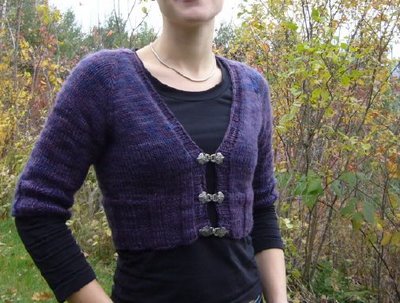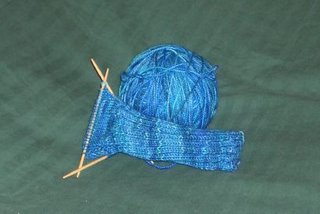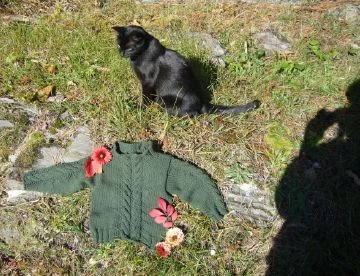I'm all abuzz with inspiration after attending a natural dyes workshop last Saturday. It was at St. Brigid's Farm in Peacham, VT, which had the most wonderful fiber workroom in a converted garage - overflowing bags of mohair, spinning wheels, three looms, and an excellent staging area for dyeing. I was particularly taken with the artistic array of naturally dyed wool - this photo doesn't do justice to the colors, which ranged from deep, jewel-tone magentas to subtle, smoky purples to soft yellows and woodsy browns.

I mixed up two small dyebaths for my samples. First I got an incredibly luminous watermelon hue with cochineal and quebracho red on plain, worsted wool. Second, a gorgeous golden-caramel color using madder on tussah silk.

After that, I got to toss some fingering merino and a silk-wool blend into an indigo dyebath. I brought home the saturated samples in plastic bags. The next morning, I rinsed them in a bucket of rainwater (that's the photo above - complete with pine needles and autumn foliage) and hung them up to dry.

I'm in love. I'm already plotting all kinds of experiments with marigolds, which I pluck from the garden, and black walnuts, which I gather from carefully scoped-out trees around Cambridge. The workshop itself primarily used powdered dye extracts rather than the raw plant and insect material, but I'm really excited to try working from the natural materials too.
As an entertaining post-script, I feel I should add a few words about my only previous experience with natural dyes. When I was traveling in Peru two years ago, I was informed by a guide about the "cochinilla" bugs that infested much of the prickly pear cacti. I made my sister slink around with me and scrape a good cup or so of the fat little bugs off the cacti, intending to try dyeing something of my own. All I had that was clean and white was an unopened pack of cotton underwear - so into the bag of squished bugs it went!! Vaguely knowing something about needing something acid to fix the dye, we squeezed in a couple of limes from the market. And the results? (sigh). You can see the underwear drying in the sun here:

The fabric initially turned an amazing rich, dark fuchsia, as seen on the right. But as it dried it started to fade to murky purpley-grey, as seen in the middle. By the time they were fully dried and then re-washed, they were a dull greyish-white with icky black spots (not mildew - they dried in no time in the hot, high altitude sun). The weird thing was that for the next few months, I would occasionally find spots of magenta re-appearing on them after they were washed. But even that entertainment soon ended. I think they may end up in the marigold dyebath next.
This natural dyes workshop gave me new perspective on this incident in three ways: 1. I now understand why the dyeing didn't work. 2. I now realize how expensive cochineal is, which makes me wish I'd dried the bugs and smuggled them home instead of wasting them on lousy underwear. 3. I am thinking they might be well suited to marigolds next....
 Scarf: A short, fuzzy once-around-the-neck-and-knot-jauntily scarf
Scarf: A short, fuzzy once-around-the-neck-and-knot-jauntily scarf I couldn't get the color right with this picture - which shows both hats folded against the scarf - but hopefully you can get a sense of the marvelous texture of the yarn (click on photo for larger view). The mohair and blue-faced leicester are very pleasant on their own, but they create a most amazing fabric when combined.
I couldn't get the color right with this picture - which shows both hats folded against the scarf - but hopefully you can get a sense of the marvelous texture of the yarn (click on photo for larger view). The mohair and blue-faced leicester are very pleasant on their own, but they create a most amazing fabric when combined. 













